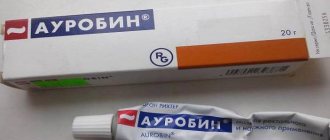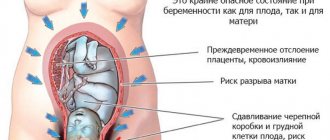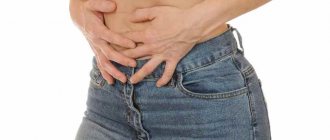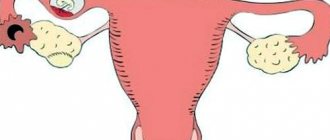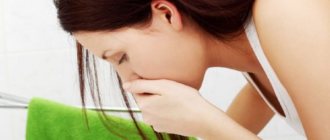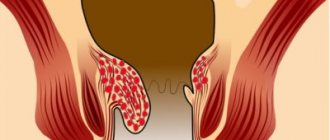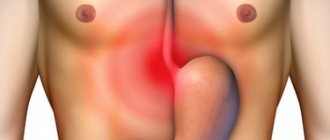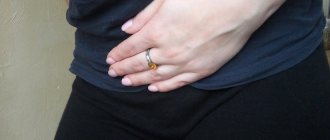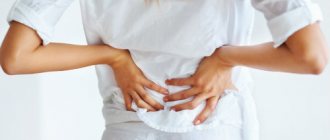Usually such a delicate problem as hemorrhoids is not accompanied by pain. The leading symptom of this disease is bleeding from the anus of varying severity. For this reason, many patients, trying to understand why the lower abdomen hurts with hemorrhoids, are confused and often think that they have been given the wrong diagnosis.
Despite widespread misconception, hemorrhoids can cause stomach pain, and in some patients the pain can be so severe that they have to call an ambulance. There are at least three main reasons why hemorrhoids can cause stomach pain.
Brief description of hemorrhoid symptoms
The main signs of hemorrhoids are the following troubles:
- itching and burning in the anus;
- swelling of the tissues around the anus;
- formation of hemorrhoidal cones;
- protrusion of nodes;
- mucous and bloody discharge;
- painful sensations.
Moreover, pain can be expressed:
- feeling of discomfort;
- heaviness in the anus;
- painful sensations during bowel movements.
Pain from hemorrhoids
To get the answer whether your stomach can hurt with hemorrhoids or not, it’s worth understanding the topic in more detail. Pain in this pathology can radiate to the lower back and also cover some areas of the back. Sometimes the perineum and legs can suffer from hemorrhoids, which is not a completely characteristic manifestation of this disease.
In some cases, such a sign is often mistaken for a symptom of a completely different illness. This phenomenon greatly complicates the diagnosis of pathology at the very beginning of the formation of the disease. It is for this reason that it is important not to miss the moment and to understand the cause of the pain. Pain in the lower abdomen most often appears at the 2nd stage of the inflammatory process of the rectum. Abdominal pain can appear in both external and internal forms of the pathological process.
However, abdominal pain due to hemorrhoids due to internal pathology is more common. This sign occurs because the intestines feel full or due to bleeding from the anus. Does the stomach hurt with external hemorrhoids? You need to answer positively, because different parts of the body can suffer from this disease. Painful sensations are caused by reflex and psychosomatic problems that also affect this area of the peritoneum, pinching hemorrhoidal cones. Localization of pain is the right side of the peritoneum or the bottom (groin area).
The connection between hemorrhoids and the lower back, the main manifestations with the location of pain
Worried about hemorrhoids
Can hemorrhoids cause severe lower back pain? Lower back pain due to hemorrhoids is explained by psychosomatic factors or a physiological disorder. The pain radiates not only to the back, but also to the sacrum. This phenomenon is explained by pinching of the hemorrhoidal cone by the sphincter or spasm of muscle tissue.
Can hemorrhoids cause pain in the sacrum and lower back? Proctologists have noted the fact that some patients complain specifically about pain in the sacrum and lower back during bowel movements. Symptoms also appear in a sitting and lying position, since at this time the load on the inflamed hemorrhoids is increased, the patient tries to change position, which leads to pain in the lower spine. An uncomfortable position for the back is expressed by a painful syndrome.
It was also noted that the disturbing symptom of the sacrum occurs due to inflammation of the rectal organ and nearby tissues. This is explained by pinching of the nerve roots in the lumbar region due to swelling of the mucous membrane.
Causes of pain in the lower abdomen
Unfavorable factors that provoke this manifestation may look like this:
- reflex and psychosomatic problems;
- colonic irritability syndrome, when during an inflammatory process inside the rectum, a nearby section of the intestine reacts to it;
- interruptions in peristalsis in the colon, when it accelerates, causing diarrhea, or slows down, causing constipation (these conditions can replace one another);
- anal fissures;
- dysfunction of the gastrointestinal tract (inflammatory pathologies can provoke pain in the lower abdomen);
- diseases of the heart and blood vessels associated with the outflow of blood (in this case, the patient may initially feel pain in the lower abdominal cavity or in the chest, only after which signs of hemorrhoids will begin to appear).
In representatives of the stronger sex, the cause of such discomfort may be hidden, in addition to the above-mentioned reasons, in other diseases. This part of the abdomen feels pain when the genitourinary system is disrupted. If you have prostatitis or other diseases, sharp painful spasms may appear. A sedentary lifestyle and poor nutrition also provoke discomfort.
In representatives of the weaker part of humanity, such signs most often appear against the background of inflammatory processes in the female genital area. Provoke the following symptom:
- inflammation of the uterus;
- ectopic pregnancy;
- erosion of the uterine cervix;
- ovarian cyst.
Pain can often occur in the lower abdomen. However, this discomfort cannot be clearly attributed to a symptom of hemorrhoids. That is why it is important to consult a doctor in a timely manner and find out the provocateur of painful manifestations.
Hemophobia in children and adults
Hemophobia is the fear of the procedure of drawing blood from a finger or from a vein. The body's spontaneous defense reaction is accompanied by an acute reaction from the patient. The internal state of fear is born due to the inevitability of pain: from the first procedure, a negative experience is stored in the child’s memory. He knows that donating blood hurts.
Hemophobia arises against a background of false expectations. Before the procedure, the little patient is told that he will not experience any pain. Deception enhances the negative experience and in adulthood the person continues to be afraid of the procedure and avoid it. Hemophobia is accompanied by other fears: fear of medical institutions or fear of infections.
For the development of fear, prerequisites are needed. People with good stress resistance are less likely to suffer from obsessive disorders. Environmental factors worsen personality resilience. Excessive stress on the psyche creates internal tension: problems at work or at home reduce defense mechanisms. As a result, physical and mental stress only intensifies the phobia, and the person experiences weakness, apathy, and becomes depressed.
Pessimism, which is another defensive reaction of the psyche, creates the preconditions for the development of fear. The more a person believes in the negative outcome of any event, the more susceptible he is to phobias.
Fear is a normal protective reaction of the body. The psyche senses a threat and immediately reacts to it. The fear of blood is not fatal, but it does affect human behavior. If the problem is a fear of blood, it is necessary to develop resistance to the sight of it. Habituation occurs along with establishing new affirmations.
Phobia with an acute reaction is less common. In most cases, the manifestation of fear is an anxious state. Psychotherapeutic techniques are used to help the patient: the level of fear is reduced, the true cause of the phobia is determined.
Emergency assistance to the patient if the fear of blood suddenly manifests itself:
- the patient sits in a comfortable position, the head tilts towards the knees (in this position, blood rushes to the head and the pressure decreases);
- breathing is restored (even breathing helps to calm down and reduce anxiety);
- After the exercise, you need to stand up and relieve tension from the muscles.
Such help is needed in cases where a panic attack interferes with diagnosis.
The primary task is to establish control over your own body. If a person cannot control the body's reactions, the phobia will only intensify over time.
Attitudes are internal beliefs that are formed in early childhood. After the first visit to the doctor, the baby forms an impression of the procedures completed. Negative experiences are the main cause of hemophobia in the future.
Impressionable people suffer from hemophobia. They are accustomed to react sharply to any environmental changes. It is difficult for hypochondriacs who are afraid of infection to cope with medical procedures.
Hemophobia is not a dangerous irrational fear. In most cases, treatment is accomplished without drug therapy. A course of sedative tablets is prescribed for increased anxiety. Sedatives provide temporary relief and are not a cure. Tranquilizers are not prescribed in case of hemophobia.
The best option for getting rid of hemophobia is physical exercise, which helps relieve excess stress. Adaptive responses are shaped by self-control skills. Breathing exercises will help you calm down in a short time. In a comfortable position (sitting or standing), it is necessary to restore breathing.
Meditation is an effective calming technique. It does not fight the cause of the phobia, but helps to counter the spontaneous reactions of the body. Meditation calms anxiety, relieves stress and muscle tension.
Yoga classes are suitable for preventing the development of additional phobias. In combination with psychoanalysis, the relaxation technique allows you to get rid of the obsessive state.
Meditation is an effective calming technique
In the modern world, it is almost impossible to avoid donating blood. The fear associated with this procedure not only brings discomfort, but also becomes a real problem. Such fear is rarely found in complex forms; it can be overcome without the additional intervention of psychologists or medications. In this case, it is worth dividing the methods of struggle according to age criteria.
For adults
If an adult is afraid of donating blood, there are a number of measures that will help him solve this problem.
- Divert your attention. The easiest way: do not look, close your eyes during the procedure.
- Don’t be afraid to warn health care workers about your fear. You will not worry about the staff's reaction to your phobia, and more comfortable conditions will be created for you to reduce stress.
- Don't give yourself time to panic. There is no need to come to the hospital in advance, giving yourself time to get ready.
- Learn to relax. Try closing your eyes, take a deep breath and exhale slowly. Imagine yourself on the seashore, feel complete relaxation. Remember this feeling and try to repeat this exercise when taking the test.
- Control your breathing. Focus on normalizing your rhythm, this will distract you from what is happening.
Abdominal pain as a symptom of hemorrhoids
Pain that occurs in the rectum can be considered one of the manifestations of hemorrhoids. At the beginning of the formation of the pathology, the patient feels a tingling sensation, which causes significant discomfort during bowel movements. When the patient experiences a severe exacerbation, the pain changes the nature of the manifestations, becoming more intense. The patient feels similar discomfort in any position of the body - lying, sitting, etc.
When there are hemorrhoids, abdominal pain can have different manifestations. They are pulling, constant, sharp, cramping or aching in nature. Cramping pain is most often felt when the intestine is narrowed, which is caused by inflammation of the seals. Aching constant pain affecting the lower abdominal cavity may indicate a progressive pathological process and the addition of necrosis or peritonitis to the underlying pathology. Acute unbearable pain is typical when blood vessels are injured by hard feces.
Where else can hemorrhoids cause pain?
Also, in some patients, pain from the anus may radiate to the back, tailbone, or lower abdomen. Why is that?
Backache
In patients with hemorrhoids, the back hurts for two reasons, namely:
- during an exacerbation of hemorrhoidal disease, patients try to alleviate their condition in all sorts of ways, including taking a forced position of the body, and such positions are not always physiological and comfortable. Pain in the anus may be relieved, but excessive tension in the back muscles occurs, which will provoke pain in it;
- irradiation of back pain along the nerve roots.
Pain in the back caused by hemorrhoids typically appears only when the process worsens or its complications develop. But in any case, you need to consult a specialist who will help alleviate the condition and rule out other causes.
Pain in the tailbone
Pain in the tailbone with hemorrhoidal disease is very rare, so first of all you need to exclude other causes of pain.
But still, if the connection between pain in the coccyx and hemorrhoids is proven, then this symptom most often occurs not because of the hemorrhoidal lumps themselves, but because of the constipation that they provoke, inflammation of the perirectal tissues or rectal fistulas.
Lower abdominal pain
The main cause of pain in the lower abdomen with hemorrhoidal disease is the irradiation of pain from the rectum, which arises from damage to the nodes by hardened feces. Moreover, such a spread of pain is observed only with internal hemorrhoids.
Also, pain in the lower abdomen can be due to constipation, since with this disorder of the intestines, its walls are overly stretched by feces, which causes pain.
Methods of dealing with pain
General requirements
To remove the unpleasant feeling, it is advisable to perform the following activities.
- Relax. It is necessary to take a comfortable position to reduce pressure on the organs of the digestive system.
- Remove tight clothing that “pinches” knots. This will provide the muscles with the necessary position and help relieve spasms.
- Take antispasmodic medicine - Ibuprofen or Combispasm.
- Follow diet number 3.
- Use herbal decoctions with a laxative effect.
- Perform a peritoneal massage.
- To reduce acute abdominal pain due to hemorrhoids, you should perform an exercise. You need to spread your legs, slowly squat down and stay in this lower position for a few seconds.
- Take walks. This event will normalize intestinal activity and relieve unpleasant discomfort.
Drug treatment
It is imperative to carry out complex treatment, use suppositories, follow a regimen and diet.
Popular suppositories are drugs from the Relief group.
You can also use:
- Anestezol;
- Procto-Glyvenol;
- Proctosedyl;
- Proctosan;
- Ultraproct;
- Gepatrombin G.
For internal hemorrhoids, it is recommended to use venotonic drugs:
Before use, consultation with a proctologist is necessary.
Diet food
To alleviate the condition, you need to follow a diet. Nutrition should be aimed at normalizing blood flow in hemorrhoidal seals. To do this you will have to give up the following products:
- fatty, spicy and salty foods;
- alcohol;
- chocolate, strong tea and coffee;
- milk;
- rice;
- semolina;
- pasta;
- flour products;
- potato.
The treatment table must include fresh fruits and vegetables, herbs, which are a source of fiber. Such food helps normalize intestinal activity:
It is also necessary to consume more fermented milk products.
How to get rid of lower back pain due to hemorrhoids?
Since the main cause of lumbar pain in patients with hemorrhoids is the presence of hemorrhoids or the development of complications, you can only get rid of this unpleasant symptom by curing hemorrhoidal disease.
Treatment of hemorrhoids consists of the following principles:
- diet;
- increased physical activity;
- taking drugs that have venotonic and angioprotective effects (Venarus, Detralex, Phlebodia 600, Troxevasin, Aescusan and others);
- the use of local medications that help eliminate the unpleasant symptoms of hemorrhoids, including pain. For internal hemorrhoids, rectal suppositories are mainly used, among which the most effective are Proctosedyl M, Relief Advance, Ultraproct, Procto-Glivenol, Proctosan, Olestesin and others;
- the use of folk remedies (baths, microenemas, homemade suppositories and ointments), which complement traditional treatment.
You can also alleviate the condition with the help of painkillers, such as Spazmolgon, Nurofen, Xefocam, Nimesil and others. In cases of severe pain, novocaine blockades can be performed.
Conservative therapy is effective in the initial stages of hemorrhoids, but when the disease has reached stages 3-4, then surgical treatment has to be resorted to.
Can the lower abdomen hurt with hemorrhoids?
If the internal course of the pathology was diagnosed, then this indicates that the nodes are growing inside the anus. In this case, patients experience abdominal pain. In the external course of the disease, the bumps extend beyond the rectum, so discomfort manifests itself in the perineum and radiates to the lower back.
People perceive such abdominal pain as a symptom of indigestion, but this opinion is wrong, because pain indicates a complication of hemorrhoids. With an exacerbation of the pathology in question, the pain can be aching, sharp or cramping. It occurs during or after bowel movement and becomes intense when sitting in one place.
Often defecation is accompanied by the appearance of blood from the anus. This phenomenon is caused by injury to the vessel by hardened feces and leads to severe pain in the abdomen and groin. A person feels a pulsation in the perineum, which is explained by an inflammatory process or the occurrence of thrombosis.
If cramping pain is observed, this indicates prolapse of the nodes and narrowing of the rectal opening. Constant pain occurs with chronic hemorrhoids and does not depend on bowel movements. A strong enlargement of the node provokes intestinal obstruction and infection, so it is better to cure the pathology at the initial stage of development.
Competent therapy will help a person get rid of discomfort and pain. Initially, the exact cause of hemorrhoids is identified. A sedentary lifestyle of a girl or guy is often to blame. If the patient works in an office, then he is recommended to periodically get up from his chair and walk around the office.
When the lower abdomen hurts due to hemorrhoids, doctors prescribe the use of suppositories that are inserted into the anus. The most common suppositories are Proctosedil, Procto-Glyvenol, Proctosan, Anestezol, Ultraproct. It is recommended to use the drugs before bedtime, when the body relaxes. Suppositories based on sea buckthorn oil or ichthyol are often used.
In severe forms of the disease, hemorrhoidectomy is prescribed - a surgical procedure during which hemorrhoids are removed. But such treatment is rarely carried out, since the operation leads to serious complications.
Minor Factors
Can there be pain in the lower abdomen due to hemorrhoids? This manifestation is only one of the signs of inflammation of the rectum. Along with hemorrhoids, there are a number of pathologies and conditions that cause nausea and pain below the navel. Among them the following are most often distinguished:
- Inflammation of the uterus and its appendages, occurring against a background of nausea and flatulence. Girls and women suffer.
- Patients are concerned about frequent episodes of constipation, flatulence or diarrhea.
- Inguinal hernia strangulation. Accompanied by sharp and severe pain.
- Appendicitis. With it, the pain increases, the stomach begins to swell.
- Urolithiasis, which is characterized by the presence of painful episodes in the lumbar area. In this case, the back is one of the first to be affected.
In many cases, the pain radiates to the leg, affecting the patient’s movement. Pain in the abdomen or discomfort in the lower back is a frequent, but not obligatory, accompaniment of hemorrhoids. Such manifestations may indicate the occurrence of internal nodes. In this case, the pain does not depend on the bowel movement itself. The pain syndrome is constant and aching in nature. It is associated with the movement of feces through the intestines and peristalsis of the organ. Anyone can suffer from hemorrhoids, but for each patient the clinic develops in its own way. Sometimes the patient may feel sick.
Only timely therapy can minimize the pain symptoms of the disease. When stagnant processes are eliminated, the body’s recovery occurs quickly, the patient will almost immediately feel relief: the pain does not go anywhere. Such therapy will free a person from pain, bloating and bleeding. Normalizing the condition will to some extent prevent the appearance of new lumps, nodes, and bulges. Complex therapy helps to ensure that your back and stomach no longer hurt.
Medical nutrition
According to doctors, you need to eat right all the time, and not just during periods of exacerbation of pathology. This will prevent the development or recurrence of the disease.
If your stomach hurts, doctors advise eating more vegetables, fruits, berries, cereals and dairy products.
Such food normalizes the functioning of the gastrointestinal tract, stimulates intestinal motility and relieves patients from constipation.
The growth of hemorrhoids is provoked by the consumption of spicy, salty, pickled, smoked foods, alcohol abuse and carbonated drinks. In addition, it is difficult for the body to digest fatty foods, which cause constipation and aggravation of hemorrhoids.
Some feel pain in the abdomen, specifically below, and do not even assume that it is hemorrhoids. But such aching pain and tingling in the sphincter area may indicate hemorrhoidal inflammation.
Some feel pain in the abdomen, specifically below, and do not even assume that it is hemorrhoids.
Many who do not yet know whether they have hemorrhoids or inflammation not in the rectum, but in another organ, are interested in the question, can the lower abdomen hurt with hemorrhoids? It seems that this is not too important, but in fact, such pain can come from the tailbone, intestines, genitals, so you need to figure it out.
Many patients do not have any special symptoms of hemorrhoids. People ignore when they have bloating, excessive gas, some kind of heaviness and pain in the lower back due to hemorrhoids, etc. But these are early signs of the disease, which is why it is important to understand how and when the lower abdomen hurts.
In the abdomen with hemorrhoids you will feel:
painful sensations below;
Constipation is becoming more common.
Other symptoms of the disease:
elastic bands in your underwear put pressure on your waist, which indicates that you have gained weight and your waist has become larger;
- it feels like there is an object in the rectum.
First one symptom appears, then another, and then they combine. Later you feel pain and tingling in the anus, hemorrhoidal pain is felt in the abdomen.
Later, these symptoms are joined by such signs of illness as:
There is a nagging itching at the anus.
Feces and urine are retained and you feel signs of intoxication in your body.
The temperature with hemorrhoids becomes higher.
When a patient develops hemorrhoids, he may feel pain in the lower abdomen, general weakness and some apathy. Erectile function in middle-aged men may be impaired, which seriously worries them, but it’s “just” the intestine being inflamed.
Diagnosis of the disease
Hemorrhoids form lumps, nodes in the lower part of the rectum. Sometimes bulges appear from the anus to the outside - we are talking about the external form of the disease. In this case, complaints arise about discomfort in the back area and flatulence.
Internal neoplasms form in the lower segment of the intestine over a length of 5 cm. External neoplasms form directly in the folds of the anus. What causes of pathology can be identified? Hemorrhoidal inflammation occurs when the veins of the anus dilate. In this case, patients note severe discomfort in the lower abdomen and pain with hemorrhoids.
Symptoms are often noted in the anus. It may hurt in the lower abdomen or lower back. The localization of pain from hemorrhoids depends on the individual characteristics of the person and the type of the disease itself. Abdominal bloating often occurs. With flatulence, the condition only worsens.
In the external form, the presence of symptoms is provoked by the act of defecation. The pain is localized in the anus. Sometimes there may be pain in the lower back due to hemorrhoids or in the perineum. The internal form of the disease is more complicated. Injury to formations occurs not only during bowel movements, but also as a result of intestinal peristalsis and the constant movement of feces towards the exit. This is accompanied by pain, discomfort, and nausea.
Can the lower abdomen hurt with hemorrhoids? Maybe, if we are talking about the internal form of the disease. Sometimes such pain can even radiate somewhat into the anus. The most common type of rectal lesion is the external form. Therefore, abdominal pain due to hemorrhoids does not occur so often. But with the internal form, this situation always occurs. Discomfort may radiate to your legs.
Why does the lower abdomen hurt with hemorrhoids? There are several theories for this condition:
- Injury to the convex zones of the intestine with feces.
- Remote pain due to the peculiarities of innervation. Pain sensations are transmitted along the fibers to areas that are not disturbed. Problems arise with the legs, stomach, and back.
- With hemorrhoids, the lower back and stomach hurt due to contact with the affected areas. The painful bulge expands and comes into contact with neighboring organs.
Does your stomach hurt with hemorrhoids? With pathology, pain in women is felt during sexual intercourse, in men - during urination. Pain that radiates to different parts of the body may actually come from the intestines.
Hemorrhoidal tumors appear in those areas of the intestine that have poor venous blood flow. They often appear in places where veins bend. In such areas, stagnation and bulge occur. The pain may radiate to the groin.
The appearance of cones is a normal physiological reaction of vascular formations. Why does stagnation occur in women with hemorrhoids? The causes of the condition are different. They are usually associated with improper liver function. Can hemorrhoids be combined with other ailments?
The location of the cones themselves can significantly complicate the course of the disease. Their location is dangerous due to the periodic loss of these tumors. The external formation becomes inflamed or necrotic. This is fraught with the development of dangerous complications. Therefore, all forms of the disease must be shown to specialists in a timely manner and treated in a timely manner. The lower back may hurt from chronic injury and loss of cones. In this case, the risk of developing cancer increases.
Diagnosing the disease in the early stages is not easy - symptoms do not appear. Therefore, in most cases, pathology can be diagnosed when painful symptoms appear. The internal form is more difficult to diagnose. If there are no symptoms of bleeding, it is impossible to detect the disease. The first sign is pain in the lower abdomen, which can radiate to the groin area.
Pain in the abdomen with hemorrhoids below the navel occurs when we are talking about the internal form of the disease. If you experience such pain, you should immediately contact a specialist. Similar symptoms occur when the nodes are injured by feces. Often the clinic develops with frequent and prolonged constipation, when hard, dry feces damage and scratch protruding neoplasms.
Less commonly, symptoms of pathology occur when affected by soft feces. Such pain from hemorrhoids becomes possible only in the terminal stages of the disease, with strong protrusion of the nodes. Patients complain of bloating, and pain in such cases occurs often, because each bowel movement provokes discomfort. Usually it is the lower tier of the abdominal cavity that hurts.
Frequent flatulence, constipation and heavy bowel movements can cause pain at any stage of hemorrhoids. But if there is no constipation and bloating does not bother you, identifying the disease is problematic. The presence of abdominal pain is a nonspecific sign of problems in the body. A more detailed examination will be required to determine the true cause. Other signs in favor of hemorrhoids are: bloating, discharge in the form of mucus and blood, itching in the anus.
Features of hemorrhoidal abdominal pain:
- worsens with defecation;
- worse in a sitting position (well known to women);
- often, along with pain, flatulence appears;
- the pain is pulsating in nature and radiates to the lower back (usually due to inflammation, prolapse or thrombosis of the formation);
- when complications occur, flatulence increases, pain becomes unbearable (the condition requires emergency medical care).
Painful sensations in the abdomen
Why do people visit a proctologist? The stomach may hurt, they may feel pain in the anus. Some people are willing to endure discomfort longer, others go to the doctor faster, but sooner or later everyone realizes that they are sick, and most likely it is hemorrhoids.
But rectal bleeding is not always so scary as to force you to seek help from a proctologist. Especially those who are ashamed of their problems.
Do you think that pain is immediately felt with this illness? This is not so, it will appear at a later stage of the development of the disease. Between 2 and 3.
This is the height of pathology, and it’s very bad if you haven’t seen a doctor yet. This behavior may also indicate that you have a low sensitivity threshold.
During the first stages, expansion is observed in the nodes. The pain will be short-lived when you are constipated or during anal sex with hemorrhoids. For your own health, it’s better not to do the latter.
When thrombosis occurs and the hemorrhoids become inflamed, you will often feel pain. Swelling occurs at the nodes, they compress the nerve endings, and the pain will be aching and quite constant. There is also a sharp pain, but it occurs when there is mechanical irritation. It is observed when:
pinching of dilated veins by the sphincter;
tightly packed and wide kale.
Such pain with hemorrhoids is called primary. They are felt precisely in the sphincter zone.
Pain may occur when cracks appear on the inside of the anus.
There are other pains that arise due to:
cracks on the inside of the anus;
disturbances in the functions of nearby tissues.
No. 3: Changing the skin of the anus
All diseases of the rectum, including hemorrhoids, are accompanied by chronic hydration of the skin surrounding the anus. Because of this, the protective properties of the epidermis are sharply disrupted, painful ulcerations appear, alternating with areas of coarsening. Ultimately, a secondary infection joins this fertile ground.
This condition is known as perianal eczema (or dermatitis). Sometimes it causes patients much more discomfort than hemorrhoids themselves, since it is accompanied not only by painful itching, but also by pain in various locations. For example, women suffering from this disease often go to the doctor complaining of pain in the lower abdomen during sex.
Anal eczema is very difficult to treat. It is reliably known that any therapy will be ineffective until the main cause of dermatitis – hemorrhoids – is eliminated. After this, a comprehensive treatment is carried out, including baths, ointments, lotions with medicinal solutions and even general drug therapy.
How does pain spread?
Does your stomach hurt with hemorrhoids? Yes. Now you know why this happens. We figured this out a little, but what is pain irradiation? Inflammation occurs in a place where there are many nerve endings, which increases pain and adds suffering to the patient.
Where are these zones? Perianal, surrounding the anus, is one of them. There are many nerve endings that are closely intertwined, so pain can be felt in other places. In turn, this provokes the development of a number of ailments.
When hemorrhoids become inflamed, pain may be felt in the lower back.
Where you will feel pain when the veins on the hemorrhoid become inflamed depends on the characteristics of your body, but most often they are felt in:
lower abdomen;
Do you feel radiating pain in those areas? This does not mean that you have hemorrhoids. Do not self-medicate. Go to an appointment with a proctologist right away, he will interview you, examine you and find out the cause of the pain syndrome.
The doctor says: “In the 1st case, a person will begin to suffer from diarrhea, and in the 2nd case, constipation. And, interestingly, both conditions exhaust the patient.”
You should not self-medicate pain. You need to immediately contact a proctologist.
What should you do after taking blood from a vein to avoid bruising?
After taking blood from a vein, some people are left with only a small wound at the puncture site, while others have a huge bruise. This happens due to venous blood getting under the skin. This can happen due to a puncture of a vein or when the patient quickly unclenches his hand after donating blood.
In order to avoid bruising, it is necessary to prevent blood from getting under the skin. When the nurse has finished drawing blood and placed a cotton swab on the puncture site, you must keep your arm bent until the blood stops completely and the wound heals. A hematoma can also appear due to too thin skin or deep veins.
Before taking a blood test from a finger or vein, you should make sure that the nurse is wearing sterile gloves and using disposable scarifiers or syringes.
Many clinics use disposable lancets instead of metal strips with a pointed end. The needle in them is hidden in a special capsule and is automatically returned after use. This eliminates contact of blood with the external environment, therefore, infection is impossible.
What is the treatment for internal hemorrhoids?
Any disease is treated faster when you see a doctor at an early stage. But even if your hemorrhoids are old, the doctor will be able to help you and significantly alleviate your suffering. The course of treatment will be longer, but you will get rid of hemorrhoids.
To identify the causes of the disease, the doctor will ask you about your lifestyle and food preferences. Many who suffer from hemorrhoids have sedentary work, and changing their specialty is not so easy, especially when it is financial.
If you work in an office, try to get up every hour, walk and do simple exercises.
If you work in an office, then try to get up every hour and walk for at least 5 minutes. Kegel exercises are good. You should try to draw in and then relax the muscles that hold the anus. This is an excellent prevention of hemorrhoids, and you can do the exercises anywhere. Do this while sitting or standing.
How to eat with hemorrhoids?
If the doctor finds out that you have developed the disease due to poor nutrition, then you must change your diet. Add porridge to it, add raw vegetables and fruits, and even just stewed vegetable dishes. Eat berries in May and summer. Thanks to this, food digestion in the intestines will improve, constipation will go away, and you will feel relief.
In the morning you will wake up with a headache and pain in the anus.
You are not allowed fatty or spicy foods, various smoked meats and pickles. During treatment, try to adhere to a balanced diet. You shouldn't eat too much either.
People with hemorrhoids should eat fruits and vegetables.
How can you treat the disease?
The doctor prescribes the medications and dosage. Go to an appointment with a proctologist.
Local treatment usually helps. The easiest way is to use suppositories. First, do an enema, empty the colon, and then insert suppositories. It is best to do this at night, when you are relaxed and getting ready for bed.
Which candles should you prefer? Ichthyol and sea buckthorn are good. Some of the best are Relief candles. Many are treated with suppositories:
When hemorrhoids strike you inside the intestine, what are the cures for hemorrhoids? Proctologists often prescribe medications that tonic the veins. They relieve inflammation and swelling. Detralex and Phlebodia 600 are considered the best.
If you have the initial stage of hemorrhoids, try to immediately begin treatment for the disease after a visit to the doctor and his prescriptions. This will help you remove painful sensations, and the pain in the abdomen, and more specifically, below, will go away. The main thing is to be able to set yourself up correctly, adhere to a balanced diet, and get treatment on time. Some patients self-medicate, but it is better not to do this, but to be treated by a proctologist.
Pain in the lower abdomen is a common occurrence in both sexes. Women find a thousand explanations for their sensations. They don’t realize that pain signals hemorrhoids. The pain due to hemorrhoids is aching, tingling closer to the lower back and anus.
Sensations arise for a number of reasons in women: menstruation, inflammation of the bladder, female organs. This makes it clear why men quickly understand the presence of intestinal disease.
For the stronger half of humanity, pain due to hemorrhoids in the lower abdomen is a common occurrence. For women, the topic of pain in the lower abdomen due to hemorrhoids causes a dilemma. Aching pain is considered a harbinger of changes in the body.
The pain is spreading in nature - you feel it in the tailbone, intestines, lower back. It goes to the groin. We suggest you figure it out and know which doctor to see.
How to eliminate back pain caused by hemorrhoids
Doctor for delicate problems
Can your back hurt if you have inflamed hemorrhoids? The clear answer is – maybe quite intensely. The disease often develops due to heavy physical labor, which explains the appearance of the syndrome in the lumbar region due to overload. To relieve disturbing sensations and reduce their intensity, it is recommended to undergo lower back massage sessions.
Such procedures help improve blood circulation and eliminate congestion in the venous plexuses of the body. It is very effective to do exercises to warm up muscles and improve the functioning of organs in the pelvis. Regular massage sessions help improve the functioning of the gastrointestinal tract, eliminate congestion, improve bowel movements, relax muscles, and eliminate soreness.
Can lower back pain only be caused by hemorrhoids? You need to know that lumbar discomfort can occur not only due to inflamed hemorrhoids, but also under the influence of other pathological processes. Therefore, when disturbing signs appear in the back, you should not think that they are caused by varicose veins of the anorectal plexuses. Perhaps the reason lies in a more serious pathology that should be found. Back pain often occurs due to inflammation of the urinary or reproductive system, vertebral hernia, and other concomitant diseases. If the symptoms in the back are pronounced, then the patient must undergo diagnostics, including an x-ray of the spinal column.
Spinal pain is a serious signal for examination. You cannot ignore the disturbing sensations by constantly taking painkillers. Timely therapy will help to avoid serious complications, for the solution of which a surgical decision is made. Very often, ignored symptoms of the spinal column end in paralysis of the musculoskeletal system.
Signs of hemorrhoids
Stop panicking. You will need to understand the structure and shape of hemorrhoids. There are internal hemorrhoids - the bumps will be inside the anus. It tends to form within 5 cm of the opening, directly in the intestine.
Hemorrhoids are enlarged veins. Pain is characteristic of any part of the pelvis. More often - the anus, less often - the lumbar region, abdomen, perineum, tailbone. The pain is localized along the vein.
The external form of the disease manifests itself in the anal area, the internal one is closer to the intestines. If an injury occurs, pain is present in the perineum and anus.
How to eliminate pain
Regardless of where the pain of hemorrhoids is localized, a person tries to get rid of it first.
In this situation, suppositories for local therapy are excellent. It is advisable to leave them overnight. Pre-wash and dry the anal area. The candles that proved to be most effective were:
- Relief;
- Hepatrombin G;
- Proctosedyl;
- Ultraproct;
- Anestezol;
- Proctoglivenol.
Suppositories with sea buckthorn oil or ichthyol will cope perfectly with pain and other unpleasant symptoms.
To relieve inflammation and swelling, you can use venotonics - Phlebodia 600 or Detralex.
It is advisable to go to a proctologist when the first symptoms or pain in the lower abdomen appear, rather than treating yourself using folk remedies.
Preventive measures will help reduce hemorrhoids and prevent frequent relapses: increasing physical activity, special exercises, for example, Kegel.
It is important to eat right and improve the quality of food digestion.
Damage to nodes
Hemorrhoids are accompanied by constipation. The stool hardens, inflammation has occurred and when it comes out it scratches the thin walls. In the external form, it occurs during exit; in the internal form, it occurs when passing through the channel. The pain spreads throughout the pelvic region and internal organs.
Causes of discomfort:
- Injuries to the intestines and mucous membranes are a common cause.
- Pain tends to be transmitted along the nerve endings connecting the pelvic organs. The neighboring parts begin to ache and ache. This is innervation.
- Contact with a diseased area (with stagnation of feces in the intestines) - organs with chronic diseases, an old form of the disease, begin to ache. Let's take sexual actions as a basis. Women will feel pain in the back, sacrum, tailbone, and lower abdomen. In men, it occurs during urination.
With the internal form of the disease, the lower abdomen pulls. Other parts of the body - tailbone, lower back, back - suffer from hemorrhoids less often. The anus is subject to problems with external hemorrhoids; aching sensations are acceptable in the abdomen and other parts of the body. The intestines suffer first.
The body reacts sharply to stagnation of feces - inflammation begins. Stagnation of blood occurs in the vessels, hemorrhoids. The disease is expressed in the form of cones, nodes, localized inside and outside. Loss of nodes provokes bleeding, tissue inflammation, and death. If you do not devote effort to treatment and prevention, the disease enters the stage of a chronic condition, and the risk of tumors and edema degenerating into oncology increases.
At the initial stage, the course of the disease is asymptomatic, it is more difficult to recognize it (in the internal form). Itching and burning in the anus, aching in the lower abdomen will indicate that the disease is beginning to develop.
Internal hemorrhoids are not always felt during the second stage. More often the tailbone hurts with internal hemorrhoids in the presence of the second, third stage of development. People don't pay attention to pain. Once bleeding appears, awareness of intestinal damage begins.
Why does my stomach and lower back hurt?
It seems to a person that the pain in the lower abdomen is inflammation of the appendages and genitourinary system. If the lower back hurts in the kidney area due to hemorrhoids, the organs let you know. The disease can cause pain in the pelvic organs.
Hemorrhoids appear specifically on the intestines - the consequences of poor nutrition and lifestyle. Parts of the body involved in the formation of nodes:
Painful sensations are caused by constipation, and fecal retention occurs. Violations:
- blood stagnation;
- blood clots in blood vessels;
- the muscles relax completely;
- vessels cease to perform functions;
- headache appears;
- intoxication occurs and so on.
These reasons put pressure and disrupt the functioning of the intestines, anus, and body. Along the nerve endings, pain can radiate to distant corners of the body. The tailbone and lower back are located nearby and are the first to suffer.
If you have any doubts about internal hemorrhoids, pay attention to pain in the back or abdomen, the following symptoms:
- The pain intensifies during bowel movements in the usual way (without constipation, loose stools).
- Pain often appears when you sit for a long time.
- If inflammation of the internal node occurs, a slight pulsation of the veins in the anus appears.
Symptoms
Aggravated hemorrhoids manifest themselves as inflammatory processes, which cannot but affect the functioning of the digestive organs and other nearby anatomical structures. Pain is localized in different parts of the body, indicates complications, its nature depends on where the hemorrhoids are located - inside or outside.
The main symptoms are prolapsed nodes, constipation, pain and burning in the anus. These factors impair blood circulation, cause venous congestion, disrupt digestion, provoke pain, difficulty defecating, bloating, and gas formation.
Gradually, over several months or years, the disease progresses, the inflammatory processes worsen, the symptoms increase, and the hemorrhoids begin to prolapse more and more.
The strength of the pain depends on:
- the presence of hemorrhoidal cones and their location, internal or external;
- patient's pain threshold;
- the stage at which the disease is located.
And if at the early stage the pain syndrome is insignificant, manifests itself only during bowel movements and passes quickly, then at subsequent stages it intensifies even with coughing or sneezing.
Often the pain becomes unbearable, and the patient develops a panicky fear of bowel movement. It delays the moment, which causes even more constipation and problems with the intestines and stomach.
At this stage, accompanying symptoms appear: pulling in the lower abdomen, radiating to the tailbone and lower lumbar region, back pain.
The cause of the pain syndrome can only be determined by a proctologist, based on the main manifestations of hemorrhoids:
- feeling of discomfort in the anus, sensation of a foreign body;
- itching and burning in the perineum;
- the presence of blood or mucus in the stool;
- painful bowel movements;
- a feeling of fullness in the intestines even after going to the toilet.
All of the above is a serious reason to contact a specialist who will conduct appropriate diagnostics and prescribe adequate treatment based on its results.
Symptoms vary depending on the types of hemorrhoids.
- Interior. It develops slowly and does not have pronounced symptoms. It is characterized by protrusion of blood vessels inside the rectum as a result of increased blood flow. During this period, the patient's pain is localized in the lower abdomen, right side, and lower back. Diarrhea or constipation, bleeding from the anus, and a feeling of fullness in the intestines appear.
- External. Hemorrhoidal cones come out. Also called anal hemorrhoids. Characterized by uncomfortable sensations and some inconvenience. In the initial form of the disease, the cones easily go inside on their own after bowel movement. On subsequent ones, they can be adjusted only by hand, and they can appear from the outside even with a slight load. Hemorrhoids radiate to the lower abdomen or tailbone.
- Mixed. The most severe, difficult to treat with medication. The main reason is neglect of one’s health, lack of adequate treatment and preventive measures. Combines signs of internal and external hemorrhoids.
What causes
Pain in the lower abdomen does not indicate 100% hemorrhoids. The causes of symptoms vary. Women and men are different.
Female
Women have a complex body, the organs are hidden inside. This applies to the reproductive organs. Localized in the pelvis. The slightest deviation from the norm of the female organs and pain appears. Everything is located in the pelvic part - it will hurt from the inside.
The female system is interconnected: if the functioning of the uterus and ovaries is disrupted, the pain will radiate to the lumbar region, tailbone, and anus. If neoplasms have formed on the female organs, during the inflammatory process the pain will be so severe that it is impossible to sit or stand. Let's consider diseases and abnormalities of the stomach. We ate, drank, accidentally swallowed something - problems and bloating began. A swollen stomach puts pressure on neighboring organs, which ache and ache.
When bloated, the lower abdomen hurts, and discomfort is often felt in the lumbar region. During an ectopic pregnancy, a woman experiences discomfort at the beginning; as the fetus develops in the fallopian tube, the pain goes far beyond the reproductive organs. The intestines, kidneys, and uterus take part in the process. Nerve endings transmit pain to neighboring parts of the body. If the intestines are involved, the pain will gradually descend to the lower abdomen, vagina, and anus. It is more difficult for women to determine the presence of internal hemorrhoids on their own and in a medical facility.
Male
Diseases are diagnosed by palpation:
- inflammation of the testicles;
- neoplasms in the genital area;
- hypothermia, poor nutrition.
Known diseases that require examination:
- Inflammatory process of the prostate gland - prostatitis. The issue is the genitourinary system, poor functioning of the glands. Urine comes out unnaturally and painfully.
- Cystitis is frequent urination with discomfort.
There are many problems. A thorough study of the symptoms of hemorrhoids will help you not to think about treating the intestines if you experience pain in the lower abdomen and these diseases of the male organs. Need help from other doctors.
How to submit?
The procedure must be approached with full responsibility. The following factors are excluded:
- Eating large amounts of fatty, fried, smoked, salty foods the day before.
- Take the day before the analysis of alcoholic beverages, smoking.
- Use of antibiotics.
- Intense physical training.
- Menstruation in women.
- Physiotherapeutic activities.
- Severe stress.
How is blood taken from a vein? The procedure is carried out on an empty stomach, so no food is taken 7-8 hours before the test. Drinking liquid is allowed, but it is only clean drinking water. The body should be alert and rested, so the day before, watching films with intense plots is excluded;
